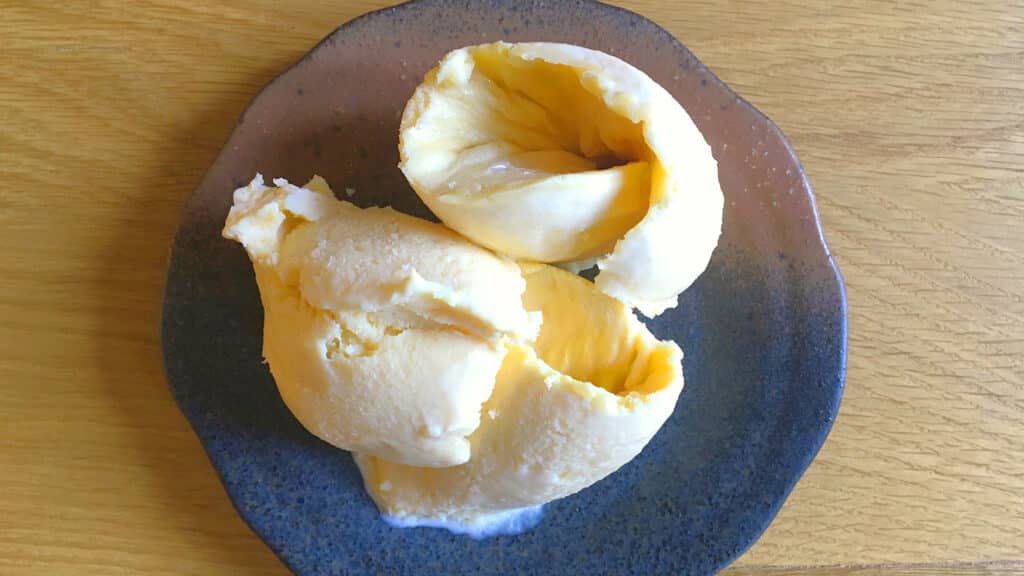The perfect homemade ice cream
Borough Market’s experts guide Daniel Tapper in his pursuit of the perfect homemade ice cream recipe


“IN THIS COUNTRY WE HAVE SOME OF THE BEST MILK IN THE WORLD – CREAMIER THAN ITALIAN MILK AND PACKED FULL OF FLAVOUR”
In many ways, making ice cream at home is tricky. It’s time-consuming and laborious, it can be more expensive than the stuff you buy from the shop, and is certainly much more difficult than dropping by the nearest gelateria. Especially if you make it without a machine.
And yet earlier this month, that is exactly what I set out to do with the help of two of Borough Market’s most respected – and patient – ice cream experts: Craig Allen, co-founder of Greedy Goat, which specialises in ice cream made using British goat’s milk, and John Marco of 3BIS Gelateria, who serves-up award-winning gelato based on a 30-year-old family recipe from Rimini.
I have to confess – it didn’t start well.
“I’m sorry, but it’s just not possible to make proper gelato or ice cream at home, unless you have an ice cream maker,” warned John. “Would I ever attempt to make ice cream at home? No, sorry, I just wouldn’t. In fact, the only tip I can give you is to avoid it altogether.” Craig wasn’t exactly brimming with enthusiasm either: “It’s so much easier with an ice cream maker – you just pour in the ingredients and it’s done in like 20 minutes.”
The technique

Fortunately, after some gentle persuasion the duo agreed to help me, inspired – I like to think – by a rant of mine bemoaning the cost of such machines and celebrating the virtues of good old elbow grease. “Okay,” said John, with a small sigh. “Let’s start with the milk and cream – both should have a decent amount of fat content, so I would always suggest whole milk and double cream. And they should always be British. In this country we have some of the best milk in the world – it’s creamier than Italian milk and is packed full of flavour, as most of the cows are grass-fed.”
Craig agreed, although his preference, unsurprisingly, was for goat’s milk. “It contains less lactose than cow’s milk, which means it can be enjoyed by many of those who are lactose intolerant,” he said. “It’s also easier to digest than cow’s milk, because the fat particles are smaller. And finally, it’s lighter and cleaner tasting, meaning you’re not left with a fatty film coating your mouth.”
If you were to freeze the milk and cream at this stage then you’d end up not with a tub of deliciously creamy ice cream but with a giant milky ice cube, which is why the second most important ingredients are eggs and sugar. The former acts as a natural emulsifier, preventing the water and fat molecules from separating, while the latter not only provides the all-important sweetness but also lowers the freezing point of the mix, ensuring it doesn’t freeze solid.
The flavourings
As for flavourings, I’ve met foodies who argue that the best ice creams are served pure and unadorned, with no need for extravagant additions – not even the faintest suggestion of vanilla. It’s an honourable idea but not one I’m willing to endorse. How can you, when faced with so many possibilities? The Greedy Goat, for example, serves more than 25 flavours on rotation, ranging from rhubarb and custard to cherry bakewell, while 3BIS offers gelato made with everything from mascarpone and figs to peanut butter and liquorice.
“Our bestseller is pistachio and this also happens to be my favourite,” said John. “But ultimately, it doesn’t matter what the flavour is – this is just personal preference. The key is sourcing the very best ingredients you can get your hands on. For example, we use pistachios from Sicily, hazelnuts from Piedmont, coconut from Sri Lanka, mango from India and strawberries from England.”
In the end I opted for Craig’s preference, earl grey tea and lemon zest. The ingredients are cheap and readily available, and this zingy flavour combination perfectly suits what is shaping-up to be one of the hottest summers in living memory.
The freeze
The initial stages of making the ice cream were surprisingly straightforward: I created a custard of milk, double cream, sugar, egg yolks and tea, which was pasteurised before being cooled and infused with fresh lemon zest. So far, so easy. The hard part, unexpectedly, was the freezing. While most recipes call for just a few hours in the freezer, my initial attempts still had the consistency of unpleasant milkshake some two days later. Not the result I was looking for.
The problem? I was using too much sugar, which was preventing the ice cream from forming large enough ice crystals. More still, the volume of ice cream I was attempting to freeze was too large, especially with a freezer struggling to hold its own in such balmy conditions. The solution was easy: in my next test batch I decreased the sugar and split the mixture between two bowls. A day later and voila, I was rewarded with a rich and velvety-smooth ice cream brimming with flavours of lemon and bergamot.
Sure, a machine might have saved me time, but what could be more important than an afternoon spent making ice cream?
Earl grey tea & lemon zest ice cream
Whisk six egg yolks vigorously in a bowl for around 5 mins and set aside. Place 250ml whole cow’s or goat’s milk, 90g icing sugar, 400ml double cream and six earl grey teabags in a heavy saucepan and heat to just before boiling point, stirring occasionally. When the milk and cream mixture reaches 80C, remove the tea bags and set them aside.
Allow the mixture to cool to room temperature before slowly stirring it into the egg yolks. Whisk until it forms a thickened custard. Add this mixture back to the pan and bring up to almost boiling point (around 80C), stirring regularly until it reaches coating consistency (thick enough to coat the back of a spoon).
Transfer the mixture into a large bowl and leave to come down to room temperature. Add the zest of a lemon and the tea bags, cover with clingfilm, and place in the fridge overnight. In the morning, remove the tea bags and decant the mixture into two shallow bowls before placing them in the freezer.
Remove the bowls from the freezer every half an hour, using a fork to whisk around the sides. This needs to be done repeatedly for the next 3 hours, or until you achieve a smooth consistency. Leave in the freezer undisturbed for at least 24 hours before serving.


